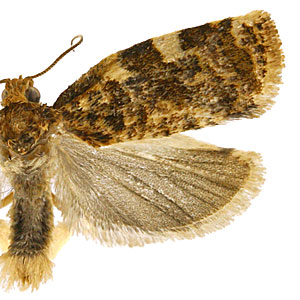Overview

The genus Archips contains more than 100 described species that are distributed throughout the Holarctic and Oriental regions. The forewing pattern of many species is similar, with a mark in the subbasal area, a well-defined median fascia, and a costal spot. Male genitalia are characterized by a fingerlike or spatulate uncus, reduced socii, well-developed gnathos, and rounded valvae. Female genitalia are characterized by a funnellike sterigma, single signum in the corpus bursae, and many species have a cestum in the ductus bursae.
This group contains a number of important pest species, such as A. podana and A. xylosteana. Larvae feed primarily on deciduous trees and shrubs, including apple, apricot, plum, pear, peach, and many others. However, most species are external leaf feeders, and fruit damage is caused by incidental feeding or when leaves are webbed to fruit.
It is difficult to distinguish between different species of Archips (or many Archipini) using larval morphology. As such, most Archips species intercepted at U.S. ports of entry are not identified beyond the subfamily level.
Ten species are treated here. Seven are common non-targets that may be encountered during surveys for A. podana, A. xylosteana, or other Tortricinae. For photos of additional non-targets not covered here, visit the Moth Photographers Group link below.
Target species
Archips crataegana
Archips fuscocupreanus
Archips podana
Archips xylosteana
Non-target species
Archips argyrospila
Archips cerasivorana
Archips grisea
Archips purpurana
Archips rosana
Archips semiferanus
Archips mortuana
Links

The following external links require an internet connection. The authors, CSU, CDFA, and USDA/APHIS/PPQ/CPHST are not responsible for the availability or content of these external sites:
Moth Photographers Group - Archipini
References

Chapman, P. J. and S. E. Lienk. 1971. Tortricid fauna of apple in New York (Lepidoptera: Tortricidae); including an account of apple's occurrence in the state, especially as a naturalized plant. Spec. Publ. Geneva, NY: New York State Agricultural Experiment Station. 122 pp.
Dombroskie, J. J. 2011. Aspects of archipine evolution (Lepidoptera: Tortricidae). University of Alberta, Department of Biological Sciences. Ph.D. dissertation. 488 pp.
Freeman, T. N. 1958. The Archipinae of North America (Lepidoptera: Tortricidae). The Canadian Entomologist Supplement 7 (Vol. 90): 1-89.
Horak, M. and R. L. Brown. 1991. Taxonomy and phylogeny, pp. 23-50. In: L. P. S. van der Geest, H. H. Evenhuis (eds.), Tortricid Pests: Their Biology, Natural Enemies and Control. Elsevier, Amsterdam, The Netherlands.
Razowski, J. 1977. Monograph of the genus Archips Hubner (Lepidoptera, Tortricidae). Acta Zoologica Cracoviensia. 22: 55-206.
Razowski, J. 1987. The genera of Tortricidae (Lepidoptera). Part 1. Palearctic Chlidanotinae and Tortricinae. Acta Zoologica Cracoviensia. 30: 141-355.

